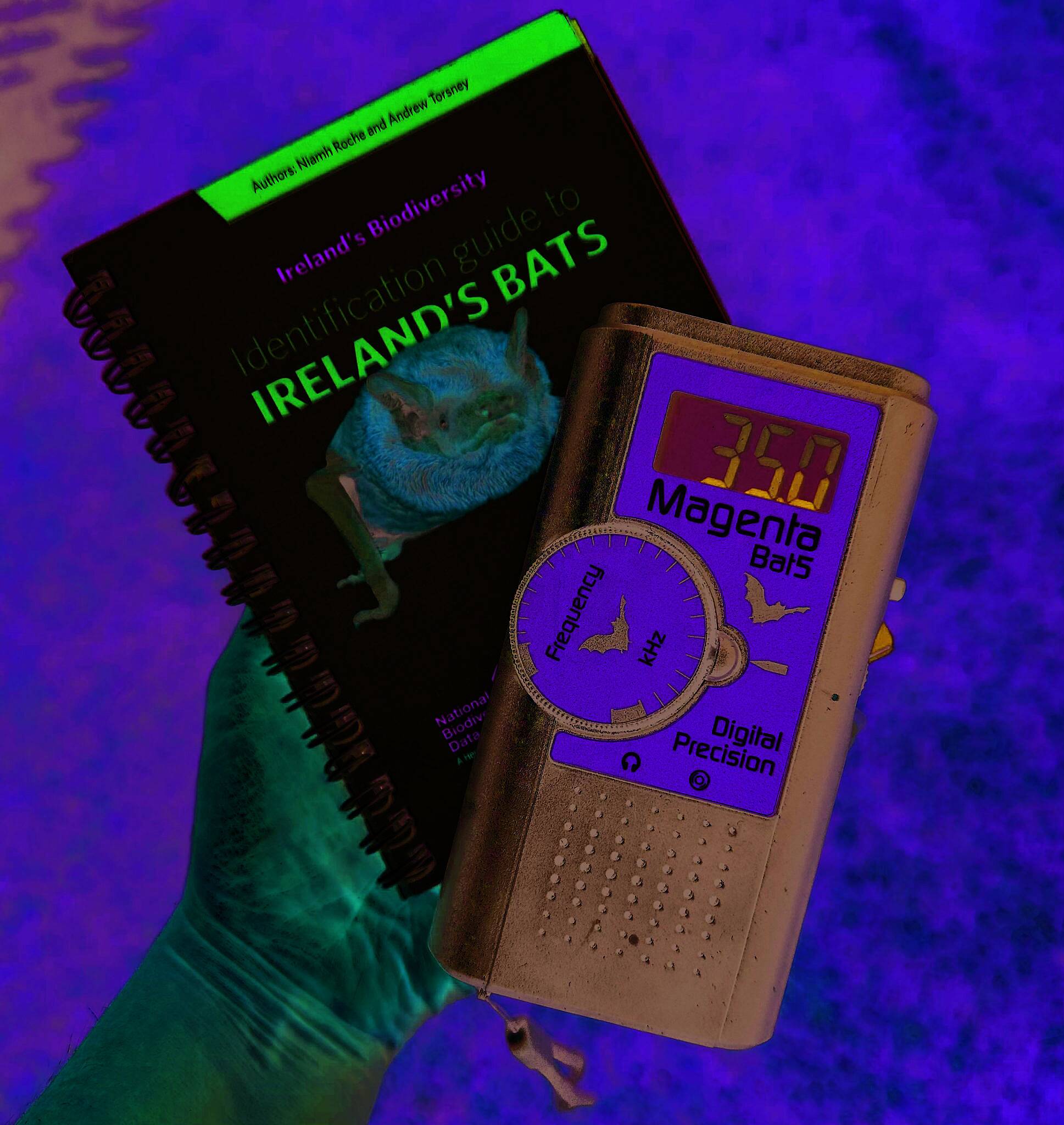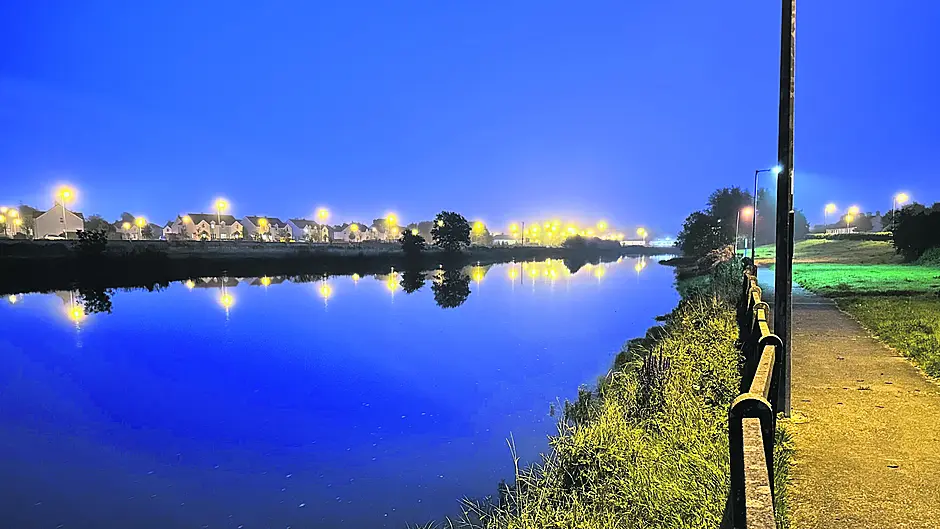WANDERING along the Ilen River after dark counting bats might sound like a strange activity. However, we did just that last week when we took part in the All-Ireland Daubenton’s Bat Waterways Survey.
Every August since 2006, Bat Conservation Ireland organises volunteers to undertake one-kilometre-long waterway surveys. We started our survey opposite the gates of Abbeystrowry cemetery, before crossing the river and continuing along the walkway to the Flax Mills. The survey involves stopping to count Daubenton’s bats every 100 metres for four-minute periods at each stop. We will repeat the survey in two weeks and submit the results of both outings to Bat Conservation Ireland for analysis.
There were a lot of bats on the wing, but we were only able to confirm a handful as being Daubenton’s, recording a total of eight ‘bat passes.’ While there was not an abundance of Daubenton’s, it was good to confirm their continued presence. Due to conditions, bat activity can vary on any given evening so we will also check how many we find on the second part of the survey.
 Important for the Daubenton’s bat survey, bat monitor and identification guide. (Photo: Ann Haigh)
Important for the Daubenton’s bat survey, bat monitor and identification guide. (Photo: Ann Haigh)
Echolocation
Daubenton’s bats have a unique flying pattern and unlike other bats they consistently fly over the river within 30cm of the surface. The survey asks that ‘bat passes’ are counted which involves counting each time a bat passes up or down the river from the survey point. To detect the approach of a Daubenton’s bat, the survey requires the use of a bat monitor. This is a device which is able to detect the specific ultrasonic calls of the various bat species and convert them into something audible for humans. Each bat species has a unique calling pattern which is detectable over a certain frequency range.
Bat calls have a specific purpose and are used for echolocation. Because bats fly in darkness, they have developed a clever way to navigate and locate their prey.
Echolocation is essentially a natural form of sonar. Bats make high pitched noises, undetectable by the human ear, which bounce off obstacles and prey and return to give them information about their surroundings. Even though bats might use their sensitive ears for navigation, as regards to their sight; the saying ‘as blind as a bat’ has little truth to it. Bats are not blind and have better vision than most humans in low light conditions.
About bats
Many people incorrectly think that bats are rodents, but they belong to the Chiroptera order and are more closely related to humans than rodents. Bats are the only mammals capable of flight and as we typically picture them, they are nocturnal and hang upside down in roosts during the day. It can seem quite mysterious where bats go in the daytime as we rarely find them. They are expert at finding small spaces to hide away in and these can include holes in trees or under bark, under roof spaces or tiles, attics, bat boxes or in small gaps in stone buildings or bridges. In summer bats will roost close to suitable insect habitats so they do not have far to fly every evening.
All Irish bat species live on a diet of insects and we do not have any vampire bats in this country! A tiny pipistrelle may consume up to 3,000 insects in one night. With insect life in grave decline, in the region of a 60% reduction in the last 20 years, bats are under pressure and it is more important than ever to look after them. They are protected under national and EU legislation and it is an offence to disturb or interfere with the bats themselves or their roosts without a licence.
When winter approaches and insects die off, bats seek somewhere to hibernate.
Hibernation locations are often different to the summer roosting areas and need to maintain a constant temperature. Locations may additionally include old barns, abandoned buildings, caves, cellars or other underground spaces.
Irish bats
There are 1,200 species of bat globally, 45 species in Europe, 18 species in Britain and only nine species in Ireland. The greatest diversity of bat species is in the tropics. In West Cork it is most commonly pipistrelles that we spot flying over our heads on summer’s evenings and they are found all over Ireland. Along with pygmy shrews, pipistrelle bats are Ireland’s smallest mammals. The common pipistrelle weighs between 4-6 grams and has a wingspan of up to 24 cm. Leisler’s bats are Ireland’s largest bat, but still only reach weights of 12-20 grams and have a wingspan of up to 32 cm. Leisler’s bats can sometimes be seen eating insects that swarm around street lights at night.
Life cycle
In Ireland pups (baby bats) are born in the summer, usually in June or July. Breeding females give birth to just one pup each year. The pups feed on their mother’s milk until they are big enough to leave the roost and hunt for insects themselves.
They usually leave the roost for the first time when they are around six weeks old. Bats are quite long-lived, with the oldest known bat being over 40 years old. In Ireland it is believed the average lifespan is seven to eight years.
Charismatic species
Of special interest to us here in West Cork is the lesser horseshoe bat. This species is restricted to six western counties from Mayo down to us here in West Cork, where there is thought to be a stronghold. Last year, the National Parks and Wildlife Service launched a species action plan for the conservation of this westerly-based species.
The bats we were counting, Daubenton’s bats, are also known as water bats due to their close association with our waterways. They hunt for insects, either catching them in flight with their mouths or by scooping them up with their feet or tail from the surface of the water. These bats generally avoid artificial light and prefer to fly in complete darkness, so it is great they continue to be detected along the well-lit walkway by Riverdale in Skibbereen.
 The scene along the Ilen river for the bat survey. (Photo: Ann Haigh)
The scene along the Ilen river for the bat survey. (Photo: Ann Haigh)
Importance of bats
Bats are important as environmental indicators; they are sensitive to ecosystem changes and changes in nocturnal insect levels. The pressures they face, such as climate change, habitat loss and fragmentation are in common with many Irish native species.
In other parts of the world, bats keep insect populations in balance, nectar-feeding bats act as pollinators and fruit-eating bats spread seeds and play an important role in reforestation.
Evening strolls
In addition to adding valuable Daubenton’s bat population data to the national records, the night-time walk along the Ilen was a wonderful experience.
Other bats, such as pipistrelles, performed aerial acrobatics closely overhead and an otter foraged in the water beside us as we scanned the water surface. We are looking forward to the next survey, but do not forget the river is there for enjoying a peaceful sunset walk at any time and you never know what wildlife you might encounter.
Ireland’s nine bat species
• Common pipistrelle
• Soprano pipistrelle
• Nathusius’ pipistrelle
• Leisler’s bat
• Brown long-eared bat
• Daubenton’s bat
• Whiskered bat
• Natterer’s bat
• Lesser horseshoe bat








